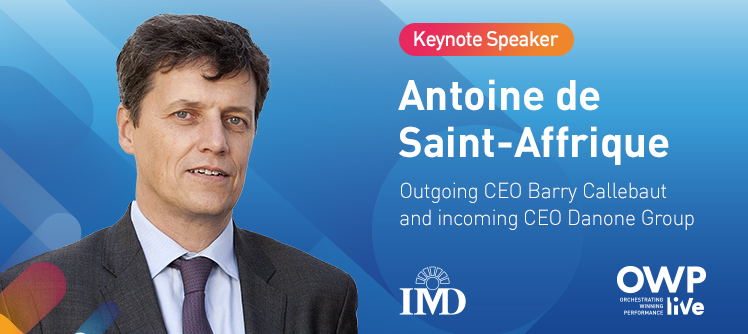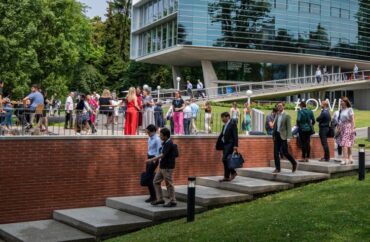After years of scepticism and resistance, the sustainability message now permeates corporate boardrooms and leadership teams, amid global concerns about climate change, food security and countless other worries.
But sustainability is not just a moral matter, linked to protecting scare and increasingly threatened natural resources, like water and forests. It is also a convincing business strategy that can grow a company’s top line by boosting brands, reputation and product differentiation, and even, ultimately, benefit profitability by saving money.
That, at least, is the approach of Antoine de Saint-Affrique, Chief Executive Officer of Barry Callebaut, the world’s biggest producer of industrial chocolate, and soon to be CEO of Danone, the multinational dairy products and waters group.
For Saint-Affrique, a 57-year-old Frenchman whose career in foods and consumer goods has encompassed jobs across Europe and Africa, sustainability is a no-brainer. Barry Callebaut’s essential raw material comes from thousands of smallholders concentrated in western Africa. Their welfare equates closely to that of the company.
“If you push your time horizon to five or 10 years, sustainability becomes a concrete business case. Business as usual is just too risky. So the choice was very clear to us”, he said.
Leaders must overcome resistance
Speaking with Saint-Affrique to the Orchestrating Winning Performance liVe audience, IMD’s President Jean-François Manzoni stressed the importance of overcoming residual fears of sustainability damaging profitability. That involves making the case not just on social grounds, but as a clear business opportunity.
Since his arrival in 2015, Saint-Affrique has done just that. Barry Callebaut’s proportion of sustainably sourced cocoa– the core product for chocolate – has soared to close to 40% of the products sold by the Group containing 100% sustainable cocoa or chocolate in fiscal year 2019/20, with the goal of making it the norm by 2025. “We are extremely proud of that”, he said.
“I put sustainability at the heart of our model. Corporate social responsibility was nice, but not necessarily good enough. It was not lasting, and it was peripheral to our business model, leaving it at risk in times of crisis”, said Saint-Affrique.
Manzoni was keen to investigate the leadership issues involved in tackling such a massive transformation. “Of course, you listen to people, including those telling you ‘You’re barking mad,” noted Saint-Affrique. “You try to understand why, to understand whether you’ve missed something big.”
“Listening is one dimension. But ultimately, you depend on your convictions as a leader. You have to be ready to stick your neck out and accept that you are accountable.”
Still, he added, these discussions could be very helpful: “friction is good; in a company where the values are shared, friction brings the problems to the surface, and then you can tackle them.”
How to lead real change
Barry Callebaut’s transformation focused on four pillars: farmer prosperity; zero child labour; thriving nature; and sustainable chocolate. While apparently uncontroversial enough, “it was clear all four were vital to ensure long term supply, long term quality, social acceptance and customer relevance,” said Saint-Affrique.
“It was clear they were all linked, and there was social as well as business relevance. Farmers who couldn’t make enough money to live on were tempted to cut down more trees, rather than boost output from their existing smallholdings.”
To solve issues in “a structural way”, it was crucial to work in partnerships, whether with governments, non-governmental organizations, customers or even, in some cases, competitors, he added. “We have a considerable amount of ‘boots on the ground’ to support cocoa farmers structure their activities. If you bring in outside expertise, you have the ability to almost triple output.”
The details that enable change
Efforts went well beyond improving productivity and trying to encourage consolidation to achieve the roughly 11-12 hectare size required for a sustainable farm, compared with the 3-5 hectare norm. They included microcredits and microinsurance to ensure farmers would not stop investing after a poor harvest. And they involved broader social steps, like providing more, or better located, wells, improving schooling and encouraging farmers to plant a wider variety of crops.
Sustainability not only addressed consumer demand and boosted a company’s reputation, but also anticipated likely rising regulatory pressure and, not least, potentially spurred innovation.
Saint-Affrique explained that Barry Callebaut now uses formerly discarded shells of cocoa pods as a source of energy in its facilities, with the by-product even serving as fertilizer. More strikingly, it has started looking entirely outside the box. The company has launched a new product, called ‘Wholefruit Chocolate’, made entirely of cacao fruit. “Cacao is the only fruit where the seeds are used, but the actual fruit is discarded,” he said.
The role of families in sustainability
Family ownership had undoubtedly helped the group take a long-term perspective. Barry Callebaut is listed on the Swiss stock exchange, but the Jacobs family, whose guiding light Klaus Jacobs created the group, retains a very close interest. Although its stake is now down to 30%, Barry Callebaut retains a close relationship with the philanthropic Jacobs Foundation.
“It always helps to have a long term shareholder which is forward thinking and forward looking.”




